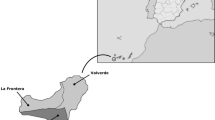Summary
A total of 202 soil samples from areas around the cities of Belo Horizonte, Santos, São Paulo, Piracicaba and Itatiaia park were examined by various techniques for the presence of fungi that may be pathogenic to humans and animals.
The fungi isolated were:Microsporon gypseum (40),M. cookei (2),Keratinomyces ajelloi (2),T. mentagrophytes (9),T. terrestre (49),T. verrucosum (2),Allescheria boydii (1),Aspergillus fumigatus (2),Candida albicans (21),Cryptococcus neoformans (4), andSporotrichum schenckii (4).
Many of the pathogenic fungi were found in habitats where they might be expected to occur in relation to activities of humans and animals.
The probable basis for the apparent absence ofParacoccidioides brasiliensis from soil samples was discussed.
The following organisms have apparently been reported for the first time from soil samples in Brasil;T. mentagrophytes, T. terrestre, T. verrucosum, A. fumigatus, C. albicans, andS. schenckii.
Similar content being viewed by others
Literature cited
Batista, A. C., Shome, S. K. &F. M. dos Santos. 1962. Pathogenicity ofParacoccidioides brasiliensis isolated from soil. Instituto de Micologia Publication No.373: 1–27.
Castro, R. M. 1961. Isolamento do dermatofitoMicrosporum gypseum de amostras de terra dos estados de São Paulo e Miñas Gerais (Brasil). Rev. Inst. Med. trop. S. Paulo3: 78–80.
Costa, S. O. P. 1961. Personal communication (toA. T. Londero. 1962. The geographic distribution and prevalence of dermatophytes in Brasil. Sabouraudia2: 108–110).
Castro, R. M. &Alchorne, M. M. de Avelar. 1962.Microsporum cookei; seu isolamento de roedores silvestres brasileiros. Rev. Inst. Med. trop. S. Paulo,4: 35–37.
Denton, J. F., McDonough, E. S., Ajello, L. &Ausherman, R. J. 1961. Isolation ofBlastomyces dermatitidis from soil. Science133: 1126–1128.
Emmons, C. W. 1961. Isolation ofHistoplasma capsulatum from soil in Washington, D.C. Public Health Rep.76(7): 591–596.
Gonçalves, A. P. 1961. Presenca doMicrosporum gypseum no solo como saprofita. Seu isolamento do solo brasileiro. Hospital (Rio de J.),60: 413–424.
Londero, A. T. &Ramos, C. 1961. Ocorrencia dos dermatofitos geofilicos no solo do Rio Grande do Sul (Brasil). Rev. Inst. Med. trop. S. Paulo3: 75–77.
Londero, A. T. 1962. The geographic distribution and prevalence of dermatophytes in Brasil. Sabouraudia2: 108–110.
Silva, M. E. 1956. Isolamento deHistoplasma capsulatum do solo em zona endemica de Calazar na Bahia, Brasil. Bol. Fund. G. Moniz10: 1–15.
Silva, M. E. 1960. Ocorrencia doCryptococcus neoformans eMicrosporum gypseum no solo da Bahia, Brasil. Bol. Fund. G. Moniz,17: 1–14.
Vanbreuseghem, R. 1952. Technique biologique pour l'isolément des dermatophytes du sol. Ann. Soc. Belge Méd. trop.32: 173–178.
Author information
Authors and Affiliations
Additional information
This investigation was supported in whole by Public Health Service Research Grant Number A1-03460, from the National Institute of Allergy and Infectious diseases.
Rights and permissions
About this article
Cite this article
Rogers, A.L., Beneke, E.S. Human pathogenic fungi recovered from Brasilian soil. Mycopathologia et Mycologia Applicata 22, 15–20 (1964). https://doi.org/10.1007/BF02058729
Issue Date:
DOI: https://doi.org/10.1007/BF02058729




